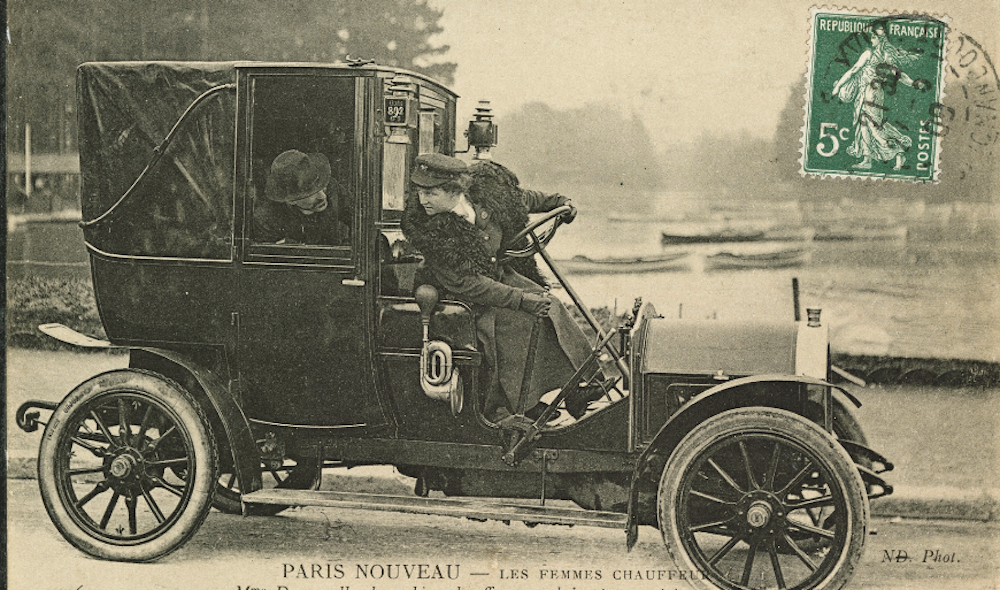
If you can read this, you almost certainly know the French word for a professional automobile driver. That’s because we use the same word in English: chauffeur. French nouns, unlike English ones, come in masculine and feminine varieties, and that -eur ending unmistakably indicates one of the former. What, then, to call a woman who works behind the wheel? Chauffeuse would be the natural option, if it didn’t already refer to a kind of fireside lounge chair. One could also feminize cocher, another word for driver, but cochère, too, is already taken by an arched entryway (which architectural detail, notably, meets the vehicular realm in the form of the porte-cochère).
As often, the difficulty of pinning down the right term here reflects the scarcity of the underlying concept. In much of the world today, driving isn’t considered the most feminine of occupations. That was even truer in the Paris of the early twentieth century, when the first woman to get her taxi license made history — or rather, when the first women to get their taxi licenses made history. A 1908 dispatch from the Motor-Car Journal’s Paris correspondent describes a certain Mademoiselle Gaby Pohlen as having “obtained her driver’s license to drive a motor taxicab from the Prefecture of Police.” Even at the time of writing, “her example has already been followed by Madame Decourcelle.”
According to Jeroen Booij at PreWarCar.com, however, “three ladies supposedly began an apprenticeship in 1906 to drive a motorized carriage in the City of Light. A lady named Madame Dufaut-Charnier supposedly got her degree as early as February 1907.” But Madame Inès Decourcelle “is believed to be the first to receive her full taxi licence in April 1908, making her the first woman in history to drive a taxi in the streets of Paris. The fact is that she became the subject of a number of daily newspaper articles claiming this, as she was seen on so many postcards from Paris naming her the first ‘femme chauffeur.’ ” After seeing one such story in Le Journal, another woman “wrote to the paper in a particularly irritated way, claiming that not Madame Decourcelle but she, Mademoiselle Gaby Pohlen, earned the title,” having started driving back in 1906.

The commenters at PreWarCar.com have put some thought toward clarifying the matter. Given the era, when the automobile itself was still a novelty, one of them suspects confusion about “whether all those named were licensed horse-drawn or motor cab drivers,” explaining that Pohlen and Decourcelles “both reportedly obtained licenses to drive motor taxi-cabs in spring 1908.” While the photogenic and somewhat eccentric Pohlen may have started out first, “Mme. Decourcelles’ claim to fame was that she was the first to get “diplomas” as both a horse ‘cochère’ and a motor ‘chauffeuse.’ ” This, another commenter adds, was “an incredible achievement at the time,” no matter which word — or words — the Académie Française approves to describe it.
Related content:
Paris Had a Moving Sidewalk in 1900, and a Thomas Edison Film Captured It in Action
The Timeless Beauty of the Citroën DS, the Car Mythologized by Roland Barthes (1957)
Take a Virtual Drive through London, Tokyo, Los Angeles & 45 Other World Cities
Robert De Niro’s Taxi Cab License Used to Prepare for Taxi Driver (1976)
Based in Seoul, Colin Marshall writes and broadcasts on cities, language, and culture. His projects include the Substack newsletter Books on Cities and the book The Stateless City: a Walk through 21st-Century Los Angeles. Follow him on Twitter at @colinmarshall or on Facebook.


It would be interesting to know if either lady took part in the famed Taxis to the Marne in September 1914. That event saw 600 of the famed Paris Taxis lined up and ready to drive French soldiers to the River Marne (making multiple trips) which stopped the German Armies advance on Paris, thus saving France from a repeat of the disastrous defeat of the Franco-Prussian War 1870–1871.